As we near the end of 2011, I’ve been browsing various websites from the pole building industry.
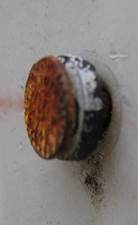 When I first entered the post frame business in 1980, nearly everyone was attaching steel roofing and siding to purlins and girts using ring shank nails with waffle heads, with rubber washers. It only took a couple of years for screw fasteners to become widely accepted in the industry.
When I first entered the post frame business in 1980, nearly everyone was attaching steel roofing and siding to purlins and girts using ring shank nails with waffle heads, with rubber washers. It only took a couple of years for screw fasteners to become widely accepted in the industry.
Over 30 years later, I am reading information on the website of one of the largest post frame building companies in America. All of this is direct quotes, you decide if it makes sense to you:
“…… recognizes that the industry is changing and we are seeing a progression to screw fasteners in the market place.”
“We will continue to follow the philosophy that a nailed roof is the best application. The nail is on the rib of the steel and the rib will shed the water away from the nail. If you put a fastener in the pan, on the roof, then you have a higher chance for a leak, because this is where the water runs.”
“For over 26 years …… has used nails due to it being the cost effective choice and the efficiency of nailing the steel on the building.”
“…….. recognizes that many clients may ask the questions about screwing on the rib of the steel. This is not an application that (this unnamed company)……. Or Fabral can support for the following reasons. 1. The nail on the roof has a specially designed silicone washer that provides a better seal on the steel rib, is larger to cover more area, and will not dry out as fast as the neoprene washer on the screw.”
Now the information above got me exploring on a more in-depth search. On the website of maybe the largest post frame builder in American, I found:
“Be prepared for the aftermath if you choose a builder that uses steel screws as fasteners. The screws – even those that are painted – become gouged and stripped when fastened. Because steel forms red rust when it’s exposed to air and water, it is not a practical choice for a fastener, especially on roof panels.
Our double hot-dipped galvanized ring shank nails include an EPDM (synthetic rubber) washer. These washers – highly resistant to deterioration by ultraviolet rays – remain flexible in extreme heat or cold. EPDM washers form an excellent seal between the nail and the steel.”
Starting from real life experience….Hansen Buildings, five years ago, purchased a piece of property in Roberts County, South Dakota. On the property is a 96’ x 96’ pole building about 20 years old at the time of acquisition. All of the steel roofing and siding was installed using ring shank nails. At the first rainfall, it was found the roof leaked like a sieve. There were hundreds of distinct leak “drip spots” on the building floor.
The choices were to replace the entire roof (best solution, however it would have been extremely costly), or repair what was there. I would never espouse the use of silicone or other sealants to repair roof leaks, however this was an extreme case and aesthetically, the sealed holes would not be visible from the ground.
A friend of mine was an engineer in the sealant industry. I described the problem to him and he fixed us up with two cases of what he described as being, “the best sealant in the world”.
Appropriately armed, the 6656 nails on the roof were attacked. Investigation found several reasons for the leaks, they included – nails which were as much as ½” above the ribs of the steel; nails with missing heads; nails where the washers had deteriorated; nails which had just plain missed the purlins in the beginning. Every nail head was rusted and staining the surrounding steel roofing.
Every last screw had to be sealed; there was no trusting any of them to not be a leaker.
In the screws which were not tight against the steel ribs, consider what happens when a fastener is driven into a piece of lumber. Drive a nail into a board and it is deforming the wood fibers downward. Drive a screw into the same board, and the screw is pulling the wood fibers upward. As the board tries to return to equilibrium, the nail is forced out by the wood fibers, the screw is pulled tighter.
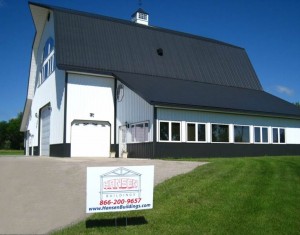 Hansen Buildings uses only screws with vulcanized grey Ethylene Propylene Diene Monomer (EPDM) beneath the heads, rather than neoprene rubber. In tests done by the German Rubber Industry Trade Association, EPDM as roofing was proven to last over 50 years. In the case of screws, the EPDM washer is further protected from weather with a domed flow cone washer.
Hansen Buildings uses only screws with vulcanized grey Ethylene Propylene Diene Monomer (EPDM) beneath the heads, rather than neoprene rubber. In tests done by the German Rubber Industry Trade Association, EPDM as roofing was proven to last over 50 years. In the case of screws, the EPDM washer is further protected from weather with a domed flow cone washer.
From Fabral’s website, “The FabrOseal (FabrOseal is a registered trademark of Fabral) galvanized ring-shank nail, with its premium long-life silicone rubber gasket, assures a lasting seal and is the best nail available for steel panels when screws are not being used by the installer.” (The bold has been added by me)
Fabral’s installation instructions states, “Screws should be installed in the flat area of the panel adjacent to the ribs…” An installation of screws on top of the steel ribs would be incorrect.
Hansen Buildings also provides screws which are powder coated rather than painted. In powder coating the paint powder is electrostatically charged and the JS500 plated screw is electrically grounded, causing the charged powder to cling to it. When oven cured the powder melts and flows over the surface including under the head, where rust would normally start. The JS500 plating afford up to ten times the lifespan of zinc plated (galvanized) screws and the manufacturer warrants the properly installed color matched finishes to last the life of the steel panels, with no red rust!
After examining the facts, I just can’t find any benefit to steel roofing or siding being attached with nails, other than to whoever sold the building attempting to increase their profit margin, at the expense of a quality product for the end user.
In Walker and Woeste’s 1992 text Post-Frame Building Design, they highlight the results of tests by Johnston and Curtis in 1984, in which comparisons were done to determine the advantages of using screws to attach steel roofing instead of nails. The study concluded, “…roofing nails driven through the roofing ridges provide for relatively poor shear transfer into roof panels…”. “The study also noted that the shear transfer through the nail connectors has caused and will continue to cause leaks as openings around the nails enlarge with time. These openings also decrease the stiffness of the roof system.”
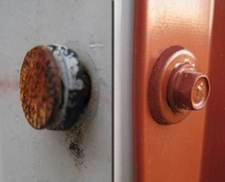 The study also concluded, “…screws should be superior to nails and this would be especially true under a repeated wind load on a building over a long time span.”
The study also concluded, “…screws should be superior to nails and this would be especially true under a repeated wind load on a building over a long time span.”
If all of this doesn’t convince you, come and look at the Hansen storage building. One look at the ring shank nails on the walls and roof will have you convinced screws are the way to go. Or take a close look at the attached photos. Seeing is believing.

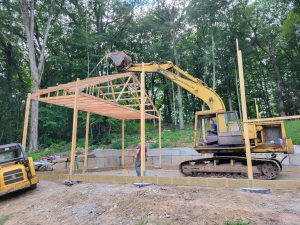
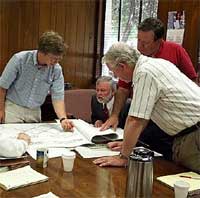






I am currently prepping my conventional shingle roof with Prime Source Grip Rit tan synthetic water(resistant-mine term)proof underlayment layered by first 4 feet is then overlayered by 2 feet etc. and that is then covered with permeable Super R Plus double sided ripstop mylar 97% reflectivity 4 feet layers over laped by 2 inches. Fir lumber 2″ X 4″ X 8′ “purlins,battens,strips” will be placed/spaced on 24″ centers and fastened with 3″ power drive wood fasteners (what type would you recommend ?) and then 3 foot wide by 2-20 foot McElroy Metals Kynar 500,26-24 gauge sheet metal in white or very light tan/sand color fastened with 2 inch metal and would self tapping screws (what would you recommend)? The McElroy instructions do state using the “top” of the ribs to attach each subsequent metal panel together and also using the fasteners in the pans “bottom” of the metal panels. They have recommend the “ZAC” metal fasteners but charge approx. .25 each! See: https://bestmaterials.com/detail.aspx?ID=15517
who sells and what is the correct discribtion of the below fasteners you mentioned?
Hansen Buildings uses only screws with vulcanized grey Ethylene Propylene Diene Monomer (EPDM) beneath the heads, rather than neoprene rubber. In tests done by the German Rubber Industry Trade Association, EPDM as roofing was proven to last over 50 years. In the case of screws, the EPDM washer is further protected from weather with a domed flow cone washer.
Thank you in advance. I spent 20 years in medical field and the last 9 in security/LEO, not a novice around building shed,barns,etc. but I have to get this metal roofing stalled correctly soon as I have been put on notice my job is being phased out and I may have to go overseas to find work. My home is 40 years old and the 7/16 plywould would need replacing but I can’t afford to pay a roofer the $13,500 for the metal built “their way” based on $5,500 of material. Thanks again.
Phil ~ For fastening the purlins, look at https://www.fastenmaster.com. For attaching the steel roofing to the purlins, 1-1/2″ Diaphragm screws would be the best choice and they are available from us.
Phil ~
For screws to attach the 2×4 threw the current roofing and sheathing, I would recommend contacting Fastenmaster at (800)518-3569. They have a broad line of construction fasteners and should be able to head you in the correct direction. Kynar is an excellent choice for a paint system, however you might consider a 29-gauge product – unless there is some specific reason to go thicker. The McElroy Max-Rib Ultra should do the trick and can be fastened to your 2×4 purlins with 1-1/2″ Diaphragm screws. As far as I know – we are the only providers in the United States of these screws as a powder coated product. We can ship them to you, in multiples of 100.
Hello,
I have a 15-year-old pole barn where ring-shank nails were used to secure the metal roof. I checked one of the nails and it just pulls out with fingers – no tools required. Should I replace each and every nail with a screw? What type of screw should I use? Should I also seal each one with sealant? If so, what is the best way to apply the sealant – over the screw after it has been put in or apply sealant and install the screw through it? If the nails are that loose are the rafters too worn to hold the screws? Can I get by with just sealing the existing nails? So many questions…
Belinda ~
You may find you have some real challenges. I would start by removing a
few of the nails and trying to replace them with a #14 diameter screw at
least 1/2″ if not an inch longer than the nails were. If these hold and
the washer/grommet of the screws is large enough in diameter to cover
the holes in the steel – then I would suggest you replace all of the
nails with these screws.
If they will not hold, and the roof steel is basically sound, you could
remove all of the steel and shift the panels over an inch or so, to
allow the screws to go into sound wood.
I can’t say as there is any sealant which I could recommend which would
provide a reasonable guarantee towards being leak free for a prolonged
period of time.
Thank you so very much for your reply – it is GREATLY appreciated!
Good morning! We are trying to remove the ringed shank nails/screw nails from our metal roof building and replacing them with pole barn screws. I am trying to find out if there is a sure fire tool to use to remove the ring shank nails? Currently we are using vice grips and it is VERY tedious work! Any suggestions?
I know of no easy way to remove the nails and reuse the roof steel. Lots of patience would be my recommendation.
A friend of mine made a metal slider that gripped the nail and then you slide a weighted piece along the straight steel piece until it impacts hard at the end forcing the nail up. I’m sure someone now manufacturers those too.
Late but for future readers. Use nail pulling pliers. End nippers. If you need to leverage them, I might use a steel plate with a bit of profile gasket that matches your roof glued to the bottom. That way you spread the pressure as you leverage off of the steel plate instead of the roofing.
Question. Is it possible to use EDPM rubber uncured and put it over the existing nail to sop the roof from leaking? Should I use uncured or form flash EDPM rubber? Any help would be great.
Trying to do a decent patch job will be near impossible. You would be best to remove the offending nail and replace it with a larger diameter screw with an EPDM washer.
I came here because I have some aluminum ring shank nails that I was consider to use on an outbuilding. I decided not to. I do want to comment however that there is a very important detail that you are leaving out of your discussion; Corrugated roofing has been traditionally attached (as noted in Fabral’s text) through the TOP of the panel profile. In any and all cases I can imagine, whether it’s nails or screws, this will give poor results as the metal moves and with an inch or so of leverage will loosen both screws and nails.
With newer profiles that offer a flat pan to seal there is no leverage issue. Ring shanked nails that did not rust might be fine depending. But screws are still likely better if driven correctly. And far easier to replace if they do loosen.